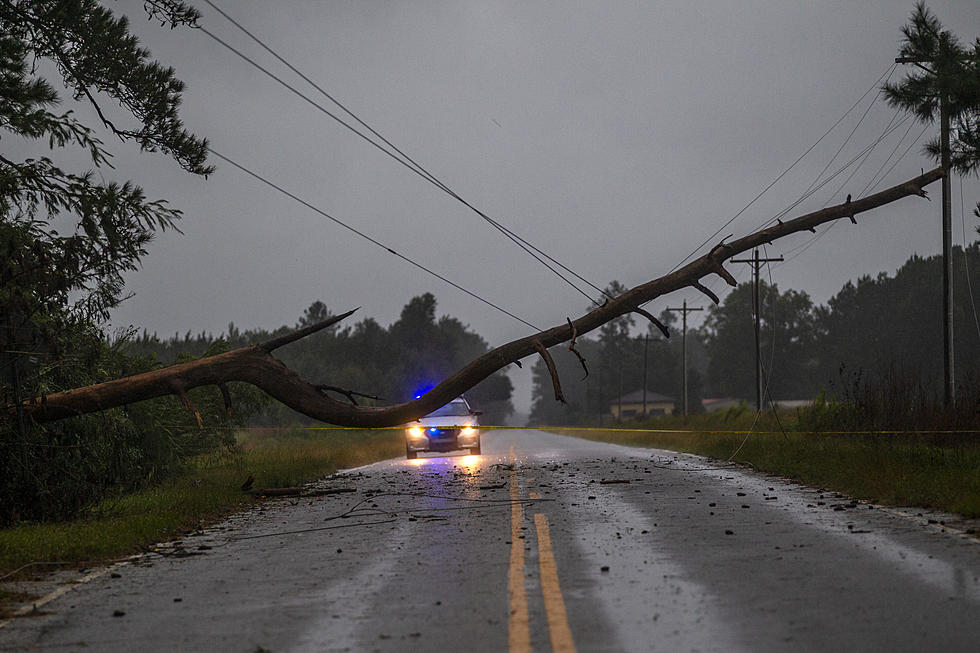
Florence stalls over Carolinas as NJ helps with rescues
MYRTLE BEACH, S.C. — Florence, now a tropical storm, swirled at a near-standstill over the Carolinas on Saturday, dumping non-stop rain over areas already flooded by seawater and swelling rivers and creeks across both states.
Some towns have already been soaked by more than 2 feet of drenching rains, and forecasters warned that totals could reach 3½ feet, unleashing floods well inland through early next week. At least four people have died, a toll authorities fear will rise as the storm crawls westward across South Carolina.
At 8 a.m. Saturday, Florence stalled about 35 miles west of Myrtle Beach, moving forward at just 2 mph, with top sustained winds of 50 mph.
North Carolina Gov. Roy Cooper called Florence an "uninvited brute" that could wipe out entire communities as it grinds its way across land.
"The fact is this storm is deadly and we know we are days away from an ending," Cooper said.
With tropical storm-force winds swirling 350 miles wide, Florence continued deluging the Carolinas on Saturday morning after pushing surging seas far ashore. Rescue crews used boats to carry more than 360 people from rising water in the river town of New Bern, North Carolina, while many of their neighbors awaited help. Dozens more were pulled from a collapsed motel.
Florence flattened trees, buckled buildings and crumpled roads. The storm knocked out power to nearly 930,000 homes and businesses, and the number could keep rising.
Members of New Jersey's Task Force 1 evacuated more than 100 residents and pets from Beaufort County along the North Carolina coast. They assisted in evacuations, water rescues and structural damage assessments.
Thirty-seven volunteers from the New Jersey chapter of the American Red Cross are spread across North Carolina, South Carolina and Virginia helping at shelters.
"I'm sure we'll be sending additional volunteers down. I know there's requests in for once the storm passes," NJ chapter spokeswoman Diane Concannon told New Jersey 101.5.
As of Thursday night, more than 20,000 people were staying in 200 Red Cross and community shelters.
A mother and baby were killed when a tree fell on a house, according to a tweet from Wilmington police. A 77-year-old man was apparently knocked down by the wind and died after going out to check on his hunting dogs, Lenoir County authorities said. The governor's office said a man was electrocuted while trying to connect extension cords in the rain.
Storm surges — the bulge of ocean water pushed ashore by the hurricane — were as high as 10 feet.
Shaken after seeing waves crashing on the Neuse River just outside his house in New Bern, restaurant owner and hurricane veteran Tom Ballance wished he had evacuated.
"I feel like the dumbest human being who ever walked the face of the earth," he said.
Florence peaked at a terrifying Category 4 with top winds of 140 mph over warm ocean water before making landfall as a Category 1 hurricane at 7:15 a.m. at Wrightsville Beach, a few miles east of Wilmington and not far from the South Carolina line. It blew ashore along a mostly boarded-up, emptied-out stretch of coastline.
But it was clear that this was really about the water, not the wind.
Morehead City, North Carolina, had received 23 inches of rain by Friday night, and forecasters warned Saturday morning that parts of the Carolinas could get up to 15 inches more.
At times, Florence was moving forward no faster than a human can walk, and it has remained such a wide storm that its counter-clockwise winds keep scooping up massive amounts of moisture from the sea. The flooding began on barrier islands in North Carolina and then spread into coastal and river communities there and in South Carolina, swamping the white sands and golf courses in North Myrtle Beach.
For people living inland in the Carolinas, maximum peril could come days later as all that water drains, overflowing rivers and causing flash floods.
Authorities warned, too, of risks of mudslides and environmental disasters from floodwaters washing over industrial waste sites and hog farms.
About 9,700 National Guard troops and civilians were deployed with high-water vehicles, helicopters and boats.
Florence could become a major test for the Federal Emergency Management Agency, which was heavily criticized as slow and unprepared last year for Hurricane Maria in Puerto Rico, where the death toll was put at nearly 3,000.
The hurricane center said the storm will eventually break up over the southern Appalachians and make a right hook to the northeast, its rainy remnants moving into the mid-Atlantic states and New England by the middle of next week.
Meteorologist Ryan Maue of weathermodels.com calculated that Florence could dump a staggering 18 trillion gallons of rain over a week on North Carolina, South Carolina, Virginia, Georgia, Tennessee, Kentucky and Maryland. That's enough to fill the Chesapeake Bay, or cover the entire state of Texas with nearly 4 inches of water.
North Carolina alone is forecast to get 9.6 trillion gallons, enough to cover the Tar Heel state to a depth of about 10 inches.
Animals taken from shelters in the southeast in order to make room for new ones because of the hurricane began arriving in New Jersey on Friday. St.Hubert's took in dogs from Mississippi and sent them to several shelters including the Monmouth County SPCA.
MCSPCA Executive Director Ross Licitra said the shelter took in 20 dogs with another 30 on the way who will all be put up for adoption.
"We are also preparing to send trucks down south full of donations food and supplies," Licitra said. Donations will be accepted at their locations at the Freehold Raceway Mall and in Eatontown during regular business hours.
They've also created a special wish list through Amazon to collect supplies in order to help shelters in the area affected by Florence.
Material from the Associated Press was used in this report.
Do you have family or friends affected by Hurricane Florence? Contact reporter Dan Alexander at Dan.Alexander@townsquaremedia.com or via Twitter @DanAlexanderNJ
More From 92.7 WOBM






